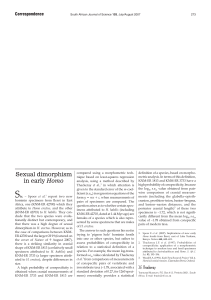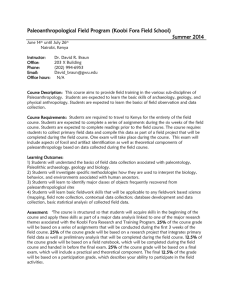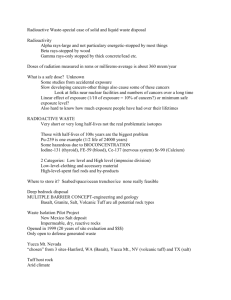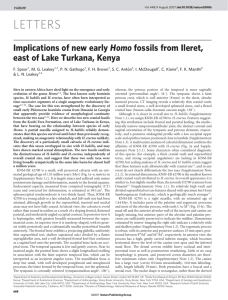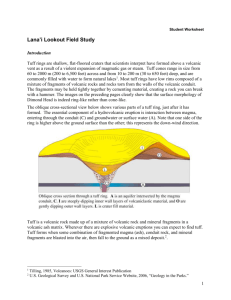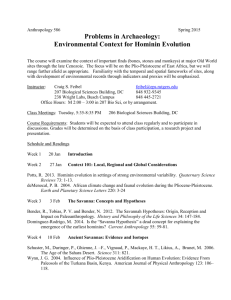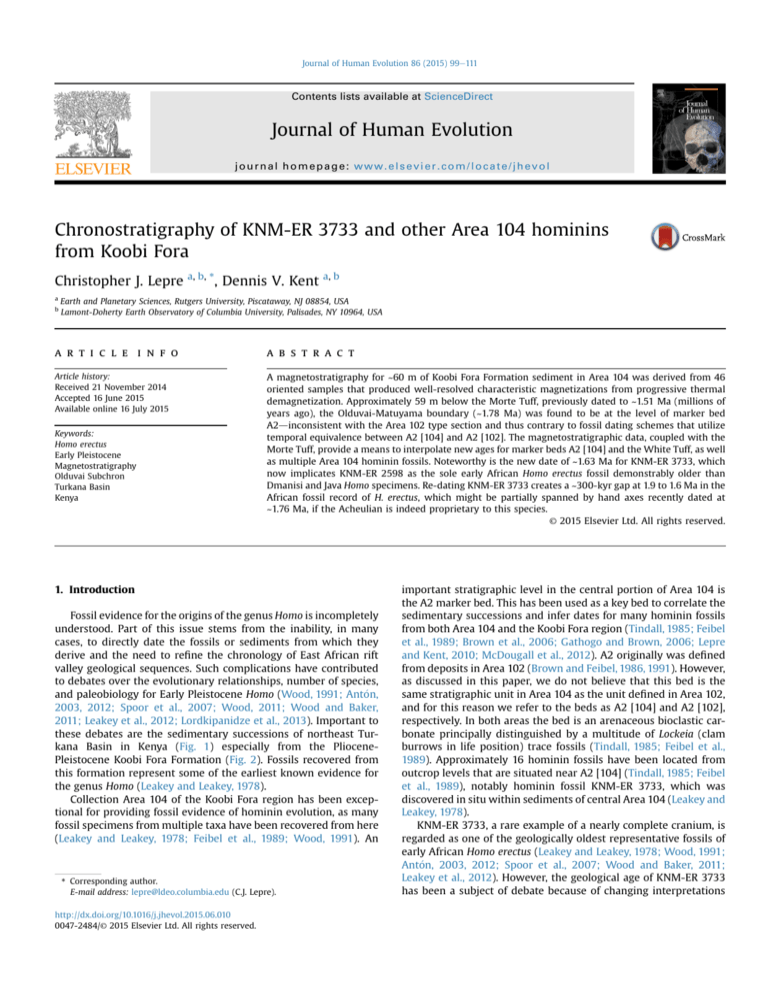
Journal of Human Evolution 86 (2015) 99e111
Contents lists available at ScienceDirect
Journal of Human Evolution
journal homepage: www.elsevier.com/locate/jhevol
Chronostratigraphy of KNM-ER 3733 and other Area 104 hominins
from Koobi Fora
Christopher J. Lepre a, b, *, Dennis V. Kent a, b
a
b
Earth and Planetary Sciences, Rutgers University, Piscataway, NJ 08854, USA
Lamont-Doherty Earth Observatory of Columbia University, Palisades, NY 10964, USA
a r t i c l e i n f o
a b s t r a c t
Article history:
Received 21 November 2014
Accepted 16 June 2015
Available online 16 July 2015
A magnetostratigraphy for ~60 m of Koobi Fora Formation sediment in Area 104 was derived from 46
oriented samples that produced well-resolved characteristic magnetizations from progressive thermal
demagnetization. Approximately 59 m below the Morte Tuff, previously dated to ~1.51 Ma (millions of
years ago), the Olduvai-Matuyama boundary (~1.78 Ma) was found to be at the level of marker bed
A2dinconsistent with the Area 102 type section and thus contrary to fossil dating schemes that utilize
temporal equivalence between A2 [104] and A2 [102]. The magnetostratigraphic data, coupled with the
Morte Tuff, provide a means to interpolate new ages for marker beds A2 [104] and the White Tuff, as well
as multiple Area 104 hominin fossils. Noteworthy is the new date of ~1.63 Ma for KNM-ER 3733, which
now implicates KNM-ER 2598 as the sole early African Homo erectus fossil demonstrably older than
Dmanisi and Java Homo specimens. Re-dating KNM-ER 3733 creates a ~300-kyr gap at 1.9 to 1.6 Ma in the
African fossil record of H. erectus, which might be partially spanned by hand axes recently dated at
~1.76 Ma, if the Acheulian is indeed proprietary to this species.
© 2015 Elsevier Ltd. All rights reserved.
Keywords:
Homo erectus
Early Pleistocene
Magnetostratigraphy
Olduvai Subchron
Turkana Basin
Kenya
1. Introduction
Fossil evidence for the origins of the genus Homo is incompletely
understood. Part of this issue stems from the inability, in many
cases, to directly date the fossils or sediments from which they
derive and the need to refine the chronology of East African rift
valley geological sequences. Such complications have contributed
to debates over the evolutionary relationships, number of species,
n,
and paleobiology for Early Pleistocene Homo (Wood, 1991; Anto
2003, 2012; Spoor et al., 2007; Wood, 2011; Wood and Baker,
2011; Leakey et al., 2012; Lordkipanidze et al., 2013). Important to
these debates are the sedimentary successions of northeast Turkana Basin in Kenya (Fig. 1) especially from the PliocenePleistocene Koobi Fora Formation (Fig. 2). Fossils recovered from
this formation represent some of the earliest known evidence for
the genus Homo (Leakey and Leakey, 1978).
Collection Area 104 of the Koobi Fora region has been exceptional for providing fossil evidence of hominin evolution, as many
fossil specimens from multiple taxa have been recovered from here
(Leakey and Leakey, 1978; Feibel et al., 1989; Wood, 1991). An
* Corresponding author.
E-mail address: lepre@ldeo.columbia.edu (C.J. Lepre).
http://dx.doi.org/10.1016/j.jhevol.2015.06.010
0047-2484/© 2015 Elsevier Ltd. All rights reserved.
important stratigraphic level in the central portion of Area 104 is
the A2 marker bed. This has been used as a key bed to correlate the
sedimentary successions and infer dates for many hominin fossils
from both Area 104 and the Koobi Fora region (Tindall, 1985; Feibel
et al., 1989; Brown et al., 2006; Gathogo and Brown, 2006; Lepre
and Kent, 2010; McDougall et al., 2012). A2 originally was defined
from deposits in Area 102 (Brown and Feibel, 1986, 1991). However,
as discussed in this paper, we do not believe that this bed is the
same stratigraphic unit in Area 104 as the unit defined in Area 102,
and for this reason we refer to the beds as A2 [104] and A2 [102],
respectively. In both areas the bed is an arenaceous bioclastic carbonate principally distinguished by a multitude of Lockeia (clam
burrows in life position) trace fossils (Tindall, 1985; Feibel et al.,
1989). Approximately 16 hominin fossils have been located from
outcrop levels that are situated near A2 [104] (Tindall, 1985; Feibel
et al., 1989), notably hominin fossil KNM-ER 3733, which was
discovered in situ within sediments of central Area 104 (Leakey and
Leakey, 1978).
KNM-ER 3733, a rare example of a nearly complete cranium, is
regarded as one of the geologically oldest representative fossils of
early African Homo erectus (Leakey and Leakey, 1978; Wood, 1991;
n, 2003, 2012; Spoor et al., 2007; Wood and Baker, 2011;
Anto
Leakey et al., 2012). However, the geological age of KNM-ER 3733
has been a subject of debate because of changing interpretations
100
C.J. Lepre, D.V. Kent / Journal of Human Evolution 86 (2015) 99e111
Figure 1. Map of the northeast Turkana Basin, northern Kenya, showing the fossil collection areas of Koobi Fora discussed in the text. Map is modified from Figs. 1 and 2 in Brown
and Feibel (1986).
over the stratigraphy of the KBS Member (Fig. 3). Using data reported by Hillhouse et al. (1977, 1986), Feibel et al. (1989) and
McDougall et al. (1992) placed the top of the Olduvai Subchron in
the type section of the KBS Member from collection Area 102 at
approximately 60 m above the stratigraphic level of the KBS Tuff
and 7 m below A2 [102]. Feibel et al. (1989) used the position of the
top of the Olduvai Subchron to estimate an age of ~1.78 Ma (millions of years ago) for A2 in the entire Koobi Fora Formation, and
reported that the stratigraphic level of KNM-ER 3733 was 6 m
above A2 [104]. Accordingly, the geological age of KNM-ER 3733,
and other hominin fossils with stratigraphic positions near A2 in
the entire Koobi Fora Formation, was determined to be ~1.78 Ma
(Feibel et al., 1989) (Panel A, Fig. 3).
Brown et al. (2006) used tephrochronology to reinterpret the
position of the top of the Olduvai Subchron in the type section of
the KBS Member at ~25 m above the KBS Tuff or ~35 m below A2
[102] (Panel B, Fig. 3). Gathogo and Brown (2006) stated that the
White Tuff, with an estimated (interpolated) age of 1.63 Ma (Brown
et al., 2006), is the nearest unequivocally identified marker level in
Area 104 that is near (<300 m geographically and ~8 m above
C.J. Lepre, D.V. Kent / Journal of Human Evolution 86 (2015) 99e111
101
stratigraphically) the KNM-ER 3733 site, and thus the fossil could
be ~130 kyr younger (Panel B, Fig. 3) than the date of ~1.78 Ma
interpreted by Feibel et al. (1989).
McDougall et al. (2012) linearly interpolated the age of the
White Tuff in Area 104 at ~1.60 Ma, using Lepre and Kent's (2010)
age of 1.71 Ma for A2 [102] and the radioisotopic date of
1.510 ± 0.016 Ma (all formal uncertainties quoted at 1s unless
otherwise noted) for the Morte Tuff (McDougall and Brown, 2006)
(Panel C, Fig. 3). In Area 104 McDougall et al. (2012) located the
KNM-ER 3733 hominin site some 230 m to the NW of a tuff
designated by Tindall (1985) as T9b, which Brown and Feibel (1986)
and Brown et al. (2006) correlated with the White Tuff. McDougall
et al. (2012) interpreted that the excavation site for KNM-ER 3733 is
about 1.5 m below the base of the White Tuff and suggested an age
of 1.65 Ma for the fossil (Panel C in Fig. 3).
To better assess the dates of the hominin fossils and the correlations with the type section of the KBS Member in Area 102, we
provide a new magnetostratigraphy for Area 104. This allows us to
place the hominin fossils that had been found there within a more
direct chronologic framework and to discuss some implications of
the refined stratigraphy.
2. Materials and methods
Figure 2. Koobi Fora Formation lithostratigraphy and nomenclature, with radiometrically determined ages of member-defining tuffs included for reference. From
McDougall et al. (2012). Note unconformities (missing section) in the Chari and Burgi
members.
Koobi Fora Formation sediments in central Area 104 are exposed
along a series of sparsely vegetated badlands. Gullies provide most
of the sedimentary exposure, as north/northwest trending
ephemeral streams erode the landscape. A majority of the sampled
outcrops and hominin fossils derive from the western part, whereas
the KNM-ER 3733 site is in the eastern part of central Area 104
(Fig. 4).
Outcrops largely consist of successions of inter-layered
mudstone and sandstone, with minor occurrences of tuff, altered
tuff (bentonite), conglomerate, and arenaceous bioclastic carbonates that consist of stromatolites, gastropods, and mollusks. These
deposits accumulated along the margins of a large paleo-lake
(Lepre, 2014), for which the depositional environments have been
previously described and interpreted (Lepre et al., 2007). A majority
of the Area 104 section has been allocated to the upper Burgi, KBS,
and Okote Members of the Koobi Fora Formation (Figs. 2 and 3),
which is based on the occurrence of the volcaniclastic markers
named the Lorenyang Tuff, White Tuff, and Morte Tuff (Tindall,
1985; Brown and Feibel, 1986; Brown et al., 2006; McDougall
et al., 2012). Of these, the Morte Tuff is the only one radiometrically dated (40Ar/39Ar) and has an eruptive age of 1.510 ± 0.016 Ma
(McDougall and Brown, 2006).
At some locations, faulting is evident from the tilting of beds
with dip slopes in the range of 3e10 . Most faults are normal as
mapped by Tindall (1985). Of importance are the NE/SW trending
faults that cut across the central part of the Area 104 study area
(Fig. 4). Faulting has uplifted lower/older strata on the western
side and down-dropped upper/younger strata on the eastern
side.
Marker beds and measured sections were investigated according to the stratigraphy and maps of Tindall (1985) in Area 104. Finegrained strata were targeted for sample collection, beginning at the
Lorenyang Tuff and working upward through the ~57m of section to
the level of the White Tuff (Fig. 3 all panels). A total of 55 samples
were collected as hand-sized blocks on which azimuth and dips
were scribed on planed surfaces before removal from the outcrop.
The cement pillar marking the KNM-ER 3733 fossil site was still in
place as of June 2011. Four samples (KNM-ER3733a, b, c and d) were
collected from a mudstone lens interbedded with sands of the fossil
excavation site.
102
C.J. Lepre, D.V. Kent / Journal of Human Evolution 86 (2015) 99e111
Figure 3. Changing views on the chronostratigraphy of KNM-ER 3733. Abbreviations: Tuff 10 (T10), Morte Tuff (MT), Tuff 9b (T9b), White Tuff (WT), A2 marker bed (A2), Tuff 1 (T1),
Lorenyang Tuff (LT), KBS Tuff (KBST), and Lower Koobi Fora Tuff (LKFT). Panel A: KNM-ER 3733 dated to ~1.78 Ma and placed at a stratigraphic position just 6 m above A2 [104]. Panel
B: KNM-ER 3733 placed at no more than 8 m below the base of T9b (¼WT) and dated to ~1.65 Ma. New radiometric dates for the LKFT and KBST are used to reassign the OlduvaiMatuyama boundary at ~25 m above the KBST in Area 102. Panel C: In Area 102, the Olduvai-Matuyama boundary properly is located at ~48 m above the KBS Tuff, and a short
reversed interval in the upper part of the Olduvai also is recognized. KNM-ER 3733 is located at ~1.5 m below the base of T9b (¼WT). In Area 104 two long polarity intervals are
interpreted as the normal Olduvai Subchron and the overlying reverse Matuyama Chron. The stratigraphic level of A2 [104] is within a complicated chron transition in the upper
part of the Olduvai that likely correlates to the short reverse polarity interval of the Area 102 magnetostratigraphy (see text). A2 [104] and A2 [102] appear to be at different
magnetostratigraphic levels. We suggest an estimated age of 1.63 Ma for KNM-ER 3733.
Hand-cut blocks were reduced to ~10 cc cubic specimens for
paleomagnetic experiments. The natural remanent magnetization
(NRM) was measured for all specimens using the 2G Model 760 DCSQUID rock magnetometer in the shielded room of the Paleomagnetics Laboratory of Lamont-Doherty Earth Observatory (Columbia
University, NY, U.S.A.). Progressive thermal demagnetization (TD)
was applied to specimens for identifying magnetization components. The TD protocol involved five steps at 100 C intervals
(100e500 C) and three steps at 25 C intervals (525e575 C).
Results of the demagnetization experiments are listed in Table 1.
Magnetic susceptibility values were determined with a Bartington
MS2B instrument for each specimen initially and after each TD step
to monitor any magneto-chemical alteration. To help constrain the
bulk magnetic mineralogy of the sediments, back-field isothermal
remanent magnetization (IRM) curves were generated for chips
from five undemagnetized specimens by giving them an IRM in
2.5 T and then in progressively higher direct fields to 2.5 T in the
opposite direction.
3. Results and discussion
3.1. Results of the magnetic measurements
Measured specimens were strongly magnetized, with an
average NRM of 130 mA/m (range from about 2 to 750 mA/m). The
main carrier of the magnetization was most probably magnetite,
given that the NRM was typically reduced to less than 10% by
575 C, which is near the Curie point of this mineral. Magnetite of
similar, albeit varying, concentrations was also indicated by the
back-field IRM curves, which showed remanent coercivities of less
than 500 mT and an approach to saturation IRM by ~0.2 T, although
small gradual increases in IRM to much higher fields suggested
some contributions from a higher coercivity mineral like hematite
(Fig. 5).
For the 46 accepted specimens a stable component interpreted
as the characteristic remanent magnetization (ChRM) was identified from a linear demagnetization trajectory that trends toward
the origin of orthogonal plots after the removal of viscous components by around 300 C (Fig. 6). These had maximum angular
deviation (MAD) values of less than 15 , calculated from principal
component analyses (e.g., Kirschvink, 1980) of data from TD steps
400 C, 500 C, 525 C, and 550 C (Table 1). This temperature range
was selected to represent the ChRM because it offered the most
number of steps that produced the fewest number of specimens
rejected for large MAD values (for example, nine rejects as
compared to 17 rejects with TD steps of 500 C, 525 C, 550 C,
575 C, and 12 rejects with TD steps of 500 C, 525 C, 550 C).
The mean ChRM directions for the 46 accepted samples separated into northerly and southerly groups (Fig. 7). Northerly and
shallow (normal polarity) directions had a mean direction of
C.J. Lepre, D.V. Kent / Journal of Human Evolution 86 (2015) 99e111
103
Figure 4. Map of central Area 104 showing geographic and geologic features and the locations of lithostratigraphic marker levels mapped by Tindall (1985). Note GPS coordinates
and placement of hominin fossil sites. Transects of examined sections after Tindall (1985) and reinvestigated during 2011 fieldwork.
D ¼ 1.8 I ¼ 4.3 (k ¼ 17.0, alpha95 ¼ 7.6 , n ¼ 23), whereas the
southerly and shallow (reverse polarity) directions had a mean
direction of D ¼ 177.2 I ¼ 6.5 (k ¼ 29.1, alpha95 ¼ 5.7, n ¼ 23).
These data passed a reversal test, classified as Rb (observed
gamma ¼ 5.1, critical gamma ¼ 12.9 ) according to the criteria of
McFadden and McElhinny (1990). After inverting the directions to
common (normal) polarity, the overall mean direction was
D ¼ 359.5 I ¼ 5.4 (k ¼ 21.5, alpha95 ¼ 4.6 ), which was only
marginally (but not significantly) shallower than the expected
geocentric axial dipole field for the locality (D ¼ 0 I ¼ 8 ).
3.2. Magnetostratigraphic interpretations
Virtual geomagnetic pole (VGP) latitudes derived from sample
ChRM directions plotted against stratigraphic thickness revealed
two polarity intervals between and inclusive of the White Tuff and
Lorenyang Tuff (Fig. 8 and Table 1). The lower ~20 m of section from
below the base of A2 [104] down to and including the Lorenyang
Tuff was characterized by positive VGP latitudes (shallow and
northerly ChRM directions), which reflect an interval of normal
polarity. The overlying ~40 m interval from above A2 [104] up to
and including the White Tuff was characterized by negative VGP
latitudes (Fig. 8 and Table 1) that signify reverse polarity (shallow
and southerly ChRM directions) (Fig. 6).
The radioisotopic date for the Morte Tuff of 1.510 ± 0.016 Ma
(McDougall and Brown, 2006) provides a key constraint for
correlation of the Area 104 magnetostratigraphy to the
Geomagnetic Polarity Time Scale (Fig. 8): the lower ~20 m of
normal polarity most probably corresponds to the younger
portion of the Olduvai Subchron (C2n) and the upper ~40 m of
reverse polarity with the succeeding portion of the Matuyama
Chron (C1r.2r).
Previous work in the northwest Turkana Basin (Lepre et al.,
2011) found a more structured character for the Olduvai to
Matuyama transition, which had also been observed in Area 102
of Koobi Fora (Lepre and Kent, 2010) and several other highresolution records (e.g., Ninkovich et al., 1966; Clement and
Kent, 1987; Heller et al., 1991; Tric et al., 1991; Holt and
Kirschvink, 1995; Kidane et al., 2003). In fact, the magnetostratigraphy of the former Global Boundary Stratotype Section and
Point for the Pliocene-Pleistocene boundary in outcrops of marine
sapropel sequences from Vrica, Italy (Tauxe et al., 1983; Zijderveld
et al., 1991) has been depicted in some astronomically tuned polarity time scales to include a ~30-kyr interval of indeterminate
polarity at the termination of the Olduvai (see Fig. 2 in Lourens
et al., 2004).
A more structured character of the Olduvai to Matuyama transition also appears to be recorded by Area 104 sediments within
a 6-m interval associated with the reversal boundary (Fig. 8). This
was inferred from the data of five specimens (104-53, -55, -56, -57,
-58) categorized as poorly resolved because of MAD values >15 .
Stepwise thermal demagnetization of these specimens revealed the
104
C.J. Lepre, D.V. Kent / Journal of Human Evolution 86 (2015) 99e111
Table 1
Paleomagnetic data for samples from the Area 104 section.
Level (m)a
Sample
MAD ( )
Dec ( )
Inc ( )
VGP lat ( )
0
1.5
2.5
3.5
4.5
5.5
6.5
6.5
7.5
7.5
8.5
8.5
9.5
9.5
10.5
11.5
14.5
15.5
16.5
16.5
17.5
18.5
19.5
20.5
21.5
22.5
23.5
24.5
25.5
27.0
28.5
29.5
30.5
31.5
32.5
33.5
34.5
35.5
36.0
37.5
38.5
39.5
40.5
42.0
43.0
44.0
46.0
50.0
50.5
51.0
52.0
52.5
53.5
55.0
56.5
104-39a
104-40
104-41
104-42
104-43
104-44a
104-31
104-45
104-32
104-46
104-33a
104-47
104-34
104-48
104-35
104-36
104-49a
104-50
104-51
104-52
104-53
104-55
104-54
104-56
104-57
104-58
104-1
104-2
104-3a
104-4
104-5
104-6
104-7
104-8
104-9
104-10
104-11
104-12
104-13
104-14
104-15
104-16
104-17
104-18
104-20
104-21a
104-30
104-22
104-23
104-24
104-25
104-26
104-27
104-29a
104-28a
2.3
2.5
5.2
12.7
4.5
2.9
4.5
2.2
2.8
9.2
6.5
9.1
4.2
4.2
3.4
2.5
1.2
1.6
1.8
7.1
42.1
29.7
6.9
20.6
17.8
18.2
2.3
3.8
8.9
5.0
4.9
4.8
6.0
4.4
34.5
15.3
3.0
4.6
15.0
6.6
10.8
10.9
7.6
11.0
11.8
2.6
12.0
5.1
4.8
2.4
7.6
40.8
8.9
4.0
1.5
359.5
31.3
13.3
23.0
6.4
358.6
0.8
2.0
6.3
7.1
2.7
351.2
5.6
0.1
355.2
358.2
359.6
0.1
7.5
355.8
225.3
26.2
6.5
348.0
340.0
31.2
176.4
177.6
181.9
170.7
184.1
187.6
181.1
2.5
46.4
136.2
168.2
156.4
354.2
173.1
182.6
186.1
184.7
165.2
169.8
160.4
294.2
176.5
169.6
189.4
185.1
10.7
178.4
184.3
190.9
1.2
3.8
3.5
3.1
2.9
3.6
3.9
4.5
17.9
1.1
7.2
27.3
23.3
12.2
12.7
17.0
7.2
6.7
0.4
9.9
9.8
6.0
11.8
5.2
15.9
20.2
2.3
11.2
2.8
5.7
10.9
7.8
7.3
20.5
39.9
28.0
0.5
6.8
0.1
13.8
15.4
15.5
3.6
10.1
0.7
14.1
2.1
0.8
4.4
19.7
2.2
46.6
3.4
7.7
48.1
85.4
58.7
76.5
66.4
81.6
84.0
84.0
87.3
75.4
82.1
87.3
76.4
80.1
79.8
84.6
85.0
89.4
82.6
81.4
85.7
44.8
62.9
83.2
76.3
66.7
58.4
85.4
87.1
84.3
80.6
85.6
82.4
88.9
83.0
41.4
42.7
77.6
66.4
82.9
82.5
85.4
82.8
84.8
72.6
78.9
67.5
24.1
84.4
79.5
78.8
84.1
56.5
84.1
85.7
62.8
a
Level (m) is the stratigraphic height in meters from base of the Lorenyang Tuff.
Thermal demagnetization steps 400 , 500 , 525 , and 550 C were used to isolate the
ChRM direction (Dec, declination, and Inc, inclination, in bedding coordinates), and
corresponding VGP latitude, positive for northern and negative for southern, using
Principal Component Analysis over thermal treatments giving MAD, maximum
angular deviation. Samples with MAD values larger than 15 indicative of lowerquality data were not used for magnetostratigraphic interpretations or Fisher
statistics.
usual normal polarity overprint to 400 C, which in these
samples masked an ill-defined and weakly developed component
at 400-575 C. The high unblocking temperature component
might be indicative of a reverse (e.g., specimen 104-53 in Figs. 6 and
8) or normal (e.g., specimen 104-58 in Figs. 6 and 8) polarity direction. Accordingly, we placed the Olduvai-Matuyama reversal
boundary at ~23 m, midway between stratigraphic positions of the
uppermost nominally normal, albeit poorly, resolved specimen (i.e.,
104-58) and the lowermost, well-resolved, reverse specimen (i.e.,
104-1).
3.3. Age model for Area 104
As initially defined (Brown and Feibel, 1986), lithostratigraphic
members of the Koobi Fora Formation are units delimited by the
positions of tuffs in a designated type section (Fig. 2). The radioisotopic dating of the tuffs adds an informal age range to a member's definition (McDougall et al., 2012). The base of the Okote
Member is formally defined by the Okote Tuff (Brown and Feibel,
1986) that has an interpolated age of 1.56 Ma with an estimated
uncertainty of ~0.05 Myr (McDougall and Brown, 2006). However,
the top of the underlying KBS Member is defined by the Lower
Koobi Fora Tuffdradioisotopically dated to 1.476 ± 0.013 Ma
(McDougall and Brown, 2006)dbecause the Okote Tuff is not
preserved within the outcrops of this member's type or reference
sections (e.g., 102-11 and 103-1 in Fig. 6 of Brown and Feibel, 1986).
The Morte Tuff with a radioisotopic date of 1.510 ± 0.016 Ma
(McDougall and Brown, 2006) provides a means to recognize the
presence of Okote Member strata in Area 104 (Brown et al., 2006).
These strata are about 0.034 Myr older than the Lower Koobi Fora
Tuff and 0.050 Myr younger than the interpolated age of the Okote
Tuff (Fig. 9).
The boundary between the Burgi and KBS Members in Area 104
is also difficult to assess because of the absence of the KBS Tuff or a
tuff with a chronostratigraphic position that is similar to the KBS. At
the type section of the KBS Member in Area 102, the KBS Tuff lies
approximately 48 m beneath the top of the Olduvai Subchron,
which is in the KBS Member, and ~40 m above the Lorenyang Tuff,
which is in the Burgi Member (Brown and Feibel, 1986; Lepre and
Kent, 2010). The Lorenyang Tuff in Area 104 is anchored to its
estimated age of 1.90 Ma that is derived from linear interpolation
between the base of the Olduvai Subchron and the KBS Tuff (cf.,
Joordens et al., 2011) in the Area 102 type section (Fig. 9). At ~5 m
above the Lorenyang Tuff in Area 104, the stratigraphic position
corresponding to the KBS Tuff's radioisotopic date of 1.869 Ma is
conditionally placed, which allows for an inferred correlation for
the top/base of the Burgi/KBS Member in Area 104 and facilitates a
chronological correlation with the member-defining boundary in
the Area 102 type section (Fig. 9).
A2 [104] lies within the transitional zone for the OlduvaiMatuyama boundary, and thus is effectively dated at 1.78 Ma
(Fig. 8). McDougall et al. (2012) estimated an age of 1.60 Ma for the
White Tuff in Area 104 based on linear interpolation between the
radioisotopic date of the Morte Tuff from Area 104
(1.510 ± 0.016 Ma; McDougall and Brown, 2006) and the estimated
age of 1.71 Ma for A2 [102] (Lepre and Kent, 2010). Our results
derive a linearly interpolated age of 1.62 Ma for the White Tuff in
Area 104 (Fig. 9) in very good agreement with the age of 1.63 Ma
reported by Brown et al. (2006) as well as 1.60 Ma reported by
McDougall et al. (2012).
3.4. Interpolated ages for hominin fossils from Area 104
McDougall et al. (2012) place KNM-ER 3733 at ~1.5 m below the
White Tuff, which is ~35 m above A2 [104]. Our paleomagnetic
results obtained from the four samples (KNM-ER 3733a, b, c, and d)
collected at the KNM-ER 3733 fossil site indicate reverse polarity
directions (Fig. 6). These results are consistent with our magnetostratigraphic framework that shows reverse polarities for the White
Tuff and the ~40 m of sediment beneath this tuff (Fig. 8 and Table 1).
We interpret that the KNM-ER 3733 fossil was recovered from
sediments carrying a reverse magnetic polarity indicative of the
C.J. Lepre, D.V. Kent / Journal of Human Evolution 86 (2015) 99e111
105
Figure 5. Upper panel (A) depicts back-field IRM acquisition curves for five specimens selected from the Area 104 section (see Fig. 8 for stratigraphic position). Small (~0.1 g) chips
from each sample were pressed into pellets using table salt and given an IRM in 2.5T, measured on the cryogenic magnetometer and then in progressively higher direct fields to 2.5T
in the opposite direction. In these plots of IRM acquisition, the sample remanent coercivity (i.e., median value) is the intersection of the acquisition curve and null IRM. Lower panel
(B) is linear acquisition plot (LAP; see Kruiver et al. (2001) for explanation of terms and methods) for a modeled mixture of two magnetic mineral components contributing to the
IRM for sample 104-29. Dotted curve represents a lower coercivity synthetic component and the dashed curve represents a higher coercivity synthetic component. Solid curve is
sum of the two components that best fit the 19 measurements shown by squares. These two components are consistent with magnetite (96% contribution to the total IRM) and
hematite (4% contribution to the total IRM).
(C1r.2r) Matuyama Chron (Panel C in Figs. 3, 8 and 9). Therefore,
KNM-ER 3733 is younger than the top of the Olduvai Subchron, i.e.,
<1.78 Ma, but older than the Morte Tuff (1.51 Ma). Linear interpolation of sediment accumulation rates between these dated horizons resolves an age of 1.63 Ma for KNM-ER 3733 (Fig. 9).
Several fossils have stratigraphic positions within 4 m beneath
the base of A2 [104] (Figs. 4 and 8) and therefore also date to
~1.78 Ma. These include (after Wood, 1974; Leakey and Leakey,
1978; Wood, 1991; Wood and Constantino, 2007): KNM-ER 814
(vault fragments), KNM-ER 813 (talus), KNM-ER 812 (mandible
fragment), KNM-ER1804 (mandible fragment), KNM-ER 3885
(isolated tooth), and KNM-ER 3886 (isolated tooth). These five
fossils from Area 104 represent some of the best age-constrained
hominins in the formation because they effectively are at the
stratigraphic level of the Olduvai-Matuyama boundary dated to
1.78 Ma.
3.5. Implications for H. erectus
Because of the anatomical incompleteness and rarity of Early
Pleistocene hominin fossils, perceptions about the human evolutionary lineage can change dramatically when new specimens are
found or the geologic ages of previously discovered ones are
revised. Both new fossils and revised dates have led to debates
about where and when H. erectus sensu lato first evolved (Swisher
n, 2003, 2012; Dennell and
et al., 1994; Gabunia et al., 2000; Anto
106
C.J. Lepre, D.V. Kent / Journal of Human Evolution 86 (2015) 99e111
Figure 6. Vector end-point plots of NRM thermal demagnetization (TD) data for representative specimens (as labeled) from the Area 104 section (see Fig. 8 for stratigraphic
positions). Open and closed symbols represent the vertical and horizontal projections, respectively, in bedding coordinates. TD treatment steps after NRM: 100 , 150 , 200 , 250 ,
300 , 350 , 400 , 450 , 500 , 525 , 550 and 575 C.
Roebroeks, 2005; Wood, 2011; Lordkipanidze et al., 2013). A
traditional view is that this taxon originated in Africa and dispersed
throughout the Old World sometime during the Early Pleistocene.
Important evidence to support this view derives from Koobi Fora, as
represented by a collection of fossils in varying degrees of
completeness that date from 2.0 to 1.5 Ma. This collection can be
portioned into two sets of fossils based on the observation that
some specimens have a geological age of nearly 2.0 Ma, whereas
others date much closer to 1.5 Ma. Previously, KNM-ER 3733 at
~1.78 Ma was placed at a chronostratigraphic position intermediate
n, 2003, 2012) and
to these two sets (e.g., Feibel et al., 1989; Anto
considered to be a direct contemporary of the oldest Homo fossils
from out-of-Africa sites like Dmanisi and Java (e.g., Swisher et al.,
1994; Gabunia et al., 2000). However, our magnetostratigraphic
C.J. Lepre, D.V. Kent / Journal of Human Evolution 86 (2015) 99e111
107
Figure 7. Equal-area projection of the ChRM sample-mean directions from the 46 accepted samples (MAD values <15 ) of the Area 104 section. Open and closed symbols are
projected onto the upper and the lower hemisphere, respectively, in bedding coordinates.
research now shows that KNM-ER 3733 at 1.63 Ma is better aligned
with the geologically younger set of early H. erectus fossils from
Koobi Fora, including partial crania KNM-ER 3883 and 42700,
incomplete skeletons KNM-ER 1808 and 803, and mandible frag n, 2003, 2012;
ments KNM-ER 992, 820 and 730 (Wood, 1991; Anto
Spoor et al., 2007; Wood and Baker, 2011; Leakey et al., 2012). Dates
for these Koobi Fora specimens fall into the range of 1.6-1.5 Ma
(Feibel et al., 1989; Brown et al., 2006; McDougall et al., 2012).
A geologically older set of fossils that includes KNM-ER 2598
and KNM-ER 3228 represents additional yet fragmentary evidence
n,
of Early Pleistocene African H. erectus (Wood, 1991, 2011; Anto
2003, 2012). Some researchers also speculate that KNM-ER 3732
n and Swisher,
might hint at an early presence of this species (Anto
2004). However, analyses on this second set of fossils do not lend
themselves to the interpretation that these fossils are all part of the
early African H. erectus hypodigm. New fossils and analyses confirm
the presence of two contemporary species of early Homo, in addition to H. erectus, in the Early Pleistocene of Koobi Fora, with one of
these non-H. erectus species partially represented by KNM-ER 3732
(Leakey et al., 2012). Similarly, KNM-ER 3228 might be interpreted
better as a post-cranial element belonging to one of the nonH. erectus taxa (McHenry and Coffing, 2000). Therefore, KNM-ER
2598 perhaps is the only one of these geologically older fossils
that potentially represents the earliest first appearance of H. erectus
n, 2003, 2012). KNM-ER
in Africa or elsewhere (Wood, 1991; Anto
2598 is an occipital fragment with a torus (Wood, 1991). Some
studies describe this as an autapomorphy of Pleistocene H. erectus
n, 2003). The stratifrom Africa and Asia (Rightmire, 1998; Anto
graphic position of KNM-ER 2598 has been placed at about 4 m
below the KBS Tuff in Area 15 and thus has a geological age of just
older than 1.87 Ma (Feibel et al., 1989; McDougall et al., 2012). It
thus predates by 200e300 kyr relatively complete H. erectus crania
KNM-ER 3733, KNM-ER 3883, and KNM-ER 42700, which are
geologically younger than several of the specimens from the oldest
out-of-Africa sites at Dmanisi (Gabunia et al., 2000; Ferring et al.,
2011) and Java (Swisher et al., 1994). Therefore, from the perspective of fossil chronostratigraphy, KNM-ER 2598 might be the lone
example providing support for the idea that H. erectus originated in
and dispersed from Africa (Fig. 10).
As intimated by Fig. 10, there is a lack of H. erectus fossils from
Koobi Fora spanning almost a 300-kyr interval between specimens
dating to ~1.9 Ma (e.g., KNM-ER 2598) and specimens dating to
~1.6 Ma (e.g., KNM-ER 3733). This perhaps represents a survey or
taphonomic bias, or evidence of an evolutionary process causing
initial low population densities at ~1.9 Ma followed by a density
increase at ~1.6 Ma. Bobe and Leakey (2009) estimate the uncertainty associated with a hominin first appearance datum (FAD) by
considering the abundance of a taxon once it appears in the fossil
record, and the abundance and distribution of samples prior to that
FAD. The timeframe that constrains the observable FAD of Homo in
the Koobi Fora Formation dates to 2.0e1.5 Ma (Feibel et al., 1989;
Wood, 1991; Leakey et al., 2012; McDougall et al., 2012). Bobe
and Leakey (2009) also point out that this FAD is biased by an
unconformity; their estimates suggest that the Homo FAD for the
108
C.J. Lepre, D.V. Kent / Journal of Human Evolution 86 (2015) 99e111
Figure 8. Stratigraphic correlation framework for hominin-bearing sediments of Area 104. Left, lithostratigraphy of Area 104 composite reference section (after Tindall, 1985; Brown
et al., 2006; McDougall and Brown, 2006; our study). At left of lithostratigraphic column marker level names/positions are indicate by bold type. Black stars on left side of lithostratigraphic column denote stratigraphic positions of KNM-ER 3733 and other hominin fossils. KNM-ER 3886, 3885, 1804, 814, 813, and 812 reported to be found at a similar
stratigraphic level, i.e., ~4 m below A2 [104] (see Tindall, 1985; Feibel et al., 1989; our Fig. 4) and the listing of these fossils in this figure is based on accession number. Center, our
sample-mean ChRM directions for Area 104 expressed as VGP latitudedapproaching þ90 for normal polarity and 90 for reverse polaritydand interpreted as magnetostratigraphic polarity intervals (filled bar ¼ normal polarity, open bar ¼ reverse polarity, gray bar ¼ tentative reverse polarity). Question marks indicate apparent normal polarity indications that may reflect an overprint in samples from intervals (i.e., at 30e37 m and again at 44e50 m) dominated by sandy sediments, whereas most rejected samples (on
account of poorly resolved data) come from a broad transition interval between the Olduvai and Matuyama (~18e24 m). See text for additional discussion of the reversal stratigraphy and placement of the Olduvai-Matuyama boundary. Right, Geomagnetic Polarity Time Scale (after Lourens et al., 2004).
Koobi Fora Formation might be at 3.0e2.5 Ma. Therefore, it is
possible that African H. erectus appeared earlier than the FAD
represented by KNM-ER 2598. The same can be said about the FAD
for the out-of-Africa sites because of the vertically short
stratigraphic records associated with the Homo fossils and lithic
artifacts (Wood, 2011). However, Acheulian tools may have been
the Lower Paleolithic technology that was originated and used
n, 2003).
exclusively by H. erectus during the Early Pleistocene (Anto
C.J. Lepre, D.V. Kent / Journal of Human Evolution 86 (2015) 99e111
109
Figure 9. Chronostratigraphic models of sedimentation for the Area 104 section and the composite type section of the Koobi Fora Formation as exposed in Areas 101, 102, and 103.
Because radioisotopic dating of tuffs implicitly adds an age range to a member's definition, we use the sedimentation rate to infer the chronostratigraphic positions of member
boundaries for Area 104 as indicated. Position of the base of the Olduvai Subchron (C2n) in Area 104 is also inferred from the sedimentation. Note different ages for marker level A2
[104] and A2 [102], and the interpolated ages of ~1.62 Ma for the White Tuff and ~1.63 Ma for KNM-ER 3733.
Lepre et al. (2011) have demonstrated that the oldest Acheulian
tools currently known date to 1.76 Ma and derive from the Kokiselei
site in the western Turkana Basin. A similar date has been reported
for the earliest Acheulian sites from the Konso Formation of
Ethiopia (Beyene et al., 2013). Therefore, if the Acheulian is indeed a
proprietary hallmark of H. erectus, then nearby hand axes dated at
1.76 Ma help to fill the gap between KNM-ER 2598 and KNM-ER
3733, and might substantiate a somewhat continual presence of
this species in northwest Kenya at 1.9e1.6 Ma.
4. Conclusions
Figure 10. Chronostratigraphic comparison of the principal cranial fossils representative of early H. erectus from Koobi Fora and the oldest out-of-Africa sites with Homo
cranial fossils, including the site preserving Oldowan stone tools at Dmanisi. Also
included is the Acheulian site of Kokiselei 4 from the Turkana Basin, preserving some
of the oldest lithics apparently associated with H. erectus in Africa.
In Area 104 the stratigraphic position of the Olduvai-Matuyama
boundary (1.78 Ma) is virtually coincident with the level of marker
bed A2 [104]. Magnetostratigraphic evidence and a paucity of
member-defining tuffs indicate complexities for correlating the A2
[104] marker bed and other strata from Area 104 to the Koobi Fora
Formation type section in Area 102 where the type occurrence of
A2 (designated here as A2 [102]) crops out.
On the basis of similarities between mollusk-packed sandstones,
bivalve molds, and algal horizons, Brown and Feibel (1986) and
Feibel et al. (1989) correlated A2 [104] to A2 [102]. Note that it is not
possible to walk and laterally follow A2 across the ~10 km of landscape between the two areas because of the discontinuous outcrops.
A2 [104] is within the interval of transitional paleomagnetic directions associated with the Olduvai-Matuyama boundary (Fig. 8).
This differs from the type section of the KBS Member where Lepre
and Kent (2010) identified ~18 m of reverse polarity section between the top of the Olduvai and the base of A2 [102] (Panel C in
Fig. 3). The lack of evident faulting, the amplitude of erosive relief,
fine grain sizes, and conformable layering for strata surrounding A2
[104] do not suggest the presence of an unconformity. Thus, A2
[102] and A2 [104] either accumulated diachronously between the
two areas or are similar-looking beds that accumulated at distinctively different chronostratigraphic levels. In either case, A2
becomes a problematical marker level for litho- or chronoestratigraphic correlations across discontinuous outcrops and between the
collecting areas of Koobi Fora. Gathogo and Brown (2006) expressed
110
C.J. Lepre, D.V. Kent / Journal of Human Evolution 86 (2015) 99e111
similar concerns. Extending A2 correlations across the basin to West
Turkana (Roche et al., 2003) also should be met with caution.
The Area 104 magnetostratigraphy provides a means to calculate new and directly interpolated dates for the A2 [104] marker
bed, White Tuff, and the hominin fossils KNM-ER 814, 813, 812,
1804, 3733, 3885, and 3886. KNM-ER 3733 dates to 1.63 Ma and
there is a dearth of H. erectus fossils from Koobi Fora that are
geologically older. Several of the oldest Homo fossils from out-ofAfrica sites, such as those from Dmanisi and Java, predate most of
the H. erectus fossils from Koobi Fora, except the fragmentary fossil
KNM-ER 2598 that dates to >1.87 Ma. An almost 300-kyr gap of
H. erectus fossils exists between Koobi Fora specimens dating to
>1.87 Ma (e.g., KNM-ER 2598) and Koobi Fora specimens dating to
1.63 Ma (e.g., KNM-ER 3733). This gap may represent an artifact of
evolutionary process or a preservation or collection bias. However,
if the Acheulian is indeed a proprietary hallmark of H. erectus, then
hand axes from the Kokiselei site dated at 1.76 Ma help to fill the
gap between KNM-ER 2598 and KNM-ER 3733, and might substantiate a somewhat continual presence of this species in northwest Kenya at 1.9e1.6 Ma.
Acknowledgments
We would like to thank the government of Kenya and the
National Museums of Kenya for their support of the research in
Koobi Fora. The Koobi Fora Research Project and the Turkana Basin
Institute are acknowledged for logistical and financial support
that made possible the fieldwork. Frank Brown and Craig Feibel
are thanked for discussing their understanding of Area 104.
Meave Leakey provided valuable on-the-ground guidance during
n are
the fieldwork. Rhonda Quinn, Ian McDougall, and Susan Anto
thanked for reading earlier drafts and providing suggestions to
improve the manuscript. The Lamont-Doherty Earth Observatory
of Columbia University is acknowledged for the ongoing support of
the Paleomagnetics Laboratory. This is Lamont-Doherty Earth
Observatory contribution #7911.
References
n, S.C., 2003. Natural history of Homo erectus. Am. J. Phys. Anthropol. 122 (S37),
Anto
126e170.
n, S.C., 2012. Early Homo. Curr. Anthropol. 53, 278e298.
Anto
n, S.C., Swisher, C.C., 2004. Early dispersals of Homo from Africa. Annu. Rev.
Anto
Anthropol. 33, 271e296.
Beyene, Y., Katoh, S., WoldeGabriel, G., Hart, W.K., Uto, K., Sudo, M., Kondo, M.,
Hyodo, M., Renne, P.R., Suwa, G., Asfaw, B., 2013. The characteristics and
chronology of the earliest Acheulean at Konso, Ethiopia. Proc. Natl. Acad. Sci.
110, 1584e1591.
Bobe, R., Leakey, M.G., 2009. Ecology of Plio-Pleistocene mammals in the OmoTurkana Basin and the emergence of Homo. In: Grine, F.E., Fleagle, J.G.,
Leakey, R.E. (Eds.), The First HumansdOrigin and Early Evolution of the Genus
Homo. Springer, Netherlands, pp. 173e184.
Brown, F.H., Feibel, C.S., 1986. Revision of lithostratigraphic nomenclature in the
Koobi Fora region, Kenya. J. Geol. Soc. 143, 297e310.
Brown, F.H., Feibel, C.S., 1991. Stratigraphy, depositional environments and palaeogeography of the Koobi Fora Formation. In: Harris, J. (Ed.), Koobi Fora Research
Project, Volume 3. Claredon, Oxford, pp. 1e30.
Brown, F.H., Haileab, B., McDougall, I., 2006. Sequence of tuffs between the KBS Tuff
and the Chari Tuff in the Turkana Basin, Kenya and Ethiopia. J. Geol. Soc. 163,
185e204.
Clement, B.M., Kent, D.V., 1987. Geomagnetic polarity transition records from five
hydraulic piston core sites in the North Atlantic. Initial. Rep. Deep Sea 94,
831e852.
Dennell, R., Roebroeks, W., 2005. An Asian perspective on early human dispersal
from Africa. Nature 438, 1099e1104.
Feibel, C.S., Brown, F.H., McDougall, I., 1989. Stratigraphic context of fossil hominids
from the Omo group deposits: Northern Turkana Basin, Kenya and Ethiopia. Am.
J. Phys. Anthropol. 78, 595e622.
Ferring, R., Oms, O., Agustí, J., Berna, F., Nioradze, M., Shelia, T., Tappen, M.,
Vekua, A., Zhvania, D., Lordkipanidze, D., 2011. Earliest human occupations at
Dmanisi (Georgian Caucasus) dated to 1.85e1.78 Ma. Proc. Natl. Acad. Sci. 108,
10432e10436.
Gabunia, L., Vekua, A., Lordkipanidze, D., Swisher, C.C., Ferring, R., Justus, A.,
n, S., Bosinski, G., Joris, O., de Lumley, M.A.,
Nioradez, M., Tvalchrelidze, M., Anto
Majsuradze, G., Mouskhelishvili, A., 2000. Earliest Pleistocene hominid cranial
remains from Dmanisi, Republic of Georgia: taxonomy, geological setting, and
age. Science 288, 1019e1025.
Gathogo, P.N., Brown, F.H., 2006. Revised stratigraphy of Area 123, Koobi Fora,
Kenya, and new age estimates of its fossil mammals, including hominins.
J. Hum. Evol. 51, 471e479.
Heller, F., Liu, X., Liu, T.S., Xu, T., 1991. Magnetic susceptibility of loess in China. Earth
Planet. Sci. Lett. 103, 301e310.
Hillhouse, J.W., Ndombi, J.W.M., Cox, A., Brock, A., 1977. Additional results on
palaeomagneticstratigraphy of the Koobi Fora Formation, east of Lake Turkana
(Lake Rudolf), Kenya. Nature 265, 411e415.
Hillhouse, J.W., Cerling, T.E., Brown, F.H., 1986. Magnetostratigraphy of the
Koobi Fora Formation, Lake Turkana, Kenya. J. Geophys. Res. 91 (B11),
11581e11595.
Holt, J.W., Kirschvink, J.L., 1995. The upper Olduvai geomagnetic field reversal from
Death Valley, California: a fold test of transitional directions. Earth Planet. Sci.
Lett. 133, 475e491.
Joordens, J.C., Vonhof, H.B., Feibel, C.S., Lourens, L.J., Dupont-Nivet, G., van der
Lubbe, J.H., Sier, M.J., Davies, G.R., Kroon, D., 2011. An astronomically-tuned
climate framework for hominins in the Turkana Basin. Earth Planet. Sci. Lett.
307, 1e8.
Kidane, T., Courtillot, V., Manighetti, I., Audin, L., Lahitte, P., Quidelleur, X., Gillot, P.Y., Gallet, Y., Carlut, J., Haile, T., 2003. New paleomagnetic and geochronologic
results from Ethiopian Afar: Block rotations linked to rift overlap and propagation and determination of a ~2 Ma reference pole for stable Africa. J. Geophys.
Res. 108, 2102.
Kirschvink, J.L., 1980. The least-squares line and plane and the analysis of palaeomagnetic data. Geophys. J. Int. 62, 699e718.
Kruiver, P.P., Dekkers, M.J., Heslop, D., 2001. Quantification of magnetic coercivity
components by the analysis of acquisition curves of isothermal remanent
magnetisation. Earth Planet. Sci. Lett. 189, 269e276.
Leakey, M.G., Leakey, R.E., 1978. Koobi Fora Research Project Volume 1. Clarendon
Press, Oxford.
n, S.C., Kiarie, C., Leakey, L.N.,
Leakey, M.G., Spoor, F., Dean, M.C., Feibel, C.S., Anto
2012. New fossils from Koobi Fora in northern Kenya confirm taxonomic diversity in early Homo. Nature 488, 201e204.
Lepre, C.J., 2014. Early Pleistocene lake formation and hominin origins in the
Turkana-Omo rift. Quatern. Sci. Rev. 102, 181e191.
Lepre, C.J., Kent, D.V., 2010. New magnetostratigraphy for the Olduvai Subchron in
the Koobi Fora Formation, northwest Kenya, with implications for early Homo.
Earth Planet. Sci. Lett. 290, 362e374.
Lepre, C.J., Quinn, R.L., Joordens, J.C.A., Swisher, C.C., Feibel, C.S., 2007. Plio-Pleistocene facies environments from the KBS Member, Koobi Fora Formation: implications for climate controls on the development of lake-margin hominin
habitats in the northeast Turkana Basin (northwest Kenya). J. Hum. Evol. 53,
504e514.
Lepre, C.J., Roche, H., Kent, D.V., Harmand, S., Quinn, R.L., Brugal, J.P., Lenoble, A.,
Texier, P.-J., Feibel, C.S., 2011. An earlier origin for the Acheulian. Nature 477,
82e85.
n, M.S.P., Margvelashvili, A., Rak, Y., Rightmire, G.P.,
Lordkipanidze, D., de Leo
Vekua, A., Zollikofer, C.P., 2013. A complete skull from Dmanisi, Georgia, and the
evolutionary biology of early Homo. Science 342, 326e331.
Lourens, L.J., Hilgen, F.J., Shackleton, N.J., Laskar, J., Wilson, D., 2004. The Neogene
period. In: Gradstein, F.M., Ogg, J.G., Smith, A.G. (Eds.), A Geologic Time Scale
2004. Cambridge University, Cambridge, pp. 409e440.
McDougall, I., Brown, F.H., 2006. Precise 40Ar/39Ar geochronology for the upper
Koobi Fora Formation, Turkana Basin, northern Kenya. J. Geol. Soc. 163,
205e220.
McDougall, I., Brown, F.H., Cerling, T.E., Hillhouse, J.W., 1992. A reappraisal of the
geomagnetic polarity time scale to 4 Ma using data from the Turkana Basin, East
Africa. Geophys. Res. Lett. 19, 2349e2352.
McDougall, I., Brown, F.H., Vasconcelos, P.M., Cohen, B.E., Thiede, D.S.,
Buchanan, M.J., 2012. New single crystal 40Ar/39Ar ages improve time scale for
deposition of the Omo Group, Omo-Turkana Basin, East Africa. J. Geol. Soc. 169,
213e226.
McFadden, P.L., McElhinny, M.W., 1990. Classification of the reversal test in palaeomagnetism. Geophys. J. Int. 103, 725e729.
McHenry, H.M., Coffing, K., 2000. Australopithecus to Homo: transformations in body
and mind. A. Rev. Anthropol. 29, 125e146.
Ninkovich, D., Opdyke, N.D., Heezen, B.C., Foster, J.H., 1966. Paleomagnetic stratigraphy, rates of deposition and tephrachronology in North Pacific deep-sea
sediments. Earth Planet. Sci. Lett. 1, 476e492.
Rightmire, G.P., 1998. Evidence from facial morphology for similarity of Asian
and African representatives of Homo erectus. Am. J. Phys. Anthropol. 106,
61e85.
Roche, H., Brugal, J.P., Delagnes, A., Feibel, C., Harmand, S., Kibunjia, M., Prat, S.,
Texier, P.-J., 2003. Plio-Pleistocene archaeological sites in the Nachukui Formation, West Turkana, Kenya: synthetic results 1997e2001. C. R. Palevol. 8,
663e673.
n, S.C., McDougall, I.,
Spoor, F., Leakey, M.G., Gathogo, P.N., Brown, F.H., Anto
Kiarie, C., Manthi, F.K., Leakey, L.N., 2007. Implications of new early Homo fossils
from Ileret, east of Lake Turkana, Kenya. Nature 448, 688e691.
C.J. Lepre, D.V. Kent / Journal of Human Evolution 86 (2015) 99e111
Swisher, C.C., Curtis, G.H., Jacob, T., Getty, A.G., Suprijo, A., 1994. Age of the earliest
known hominids in Java, Indonesia. Science 263, 1118e1121.
Tauxe, L., Opdyke, N.D., Pasini, G., Elmi, C., 1983. Age of the Plio-Pleistocene
boundary in the Vrica section, southern Italy. Nature 304, 125e129.
Tindall, K.W., 1985. Stratigraphy and sedimentology of the Koobi Fora Formation,
eastern Koobi Fora Ridge, East Turkana, Kenya. M.Sc. Thesis, Iowa State
University.
Tric, E., Laj, C., Jehanno, C., Valet, J.-P., Kissel, C., Mazaud, A., Iaccarino, S., 1991. Highresolution record of the upper Olduvai transition from Po Valley (Italy) sedimentsdsupport for dipolar transition geometry. Phys. Earth Planet. 65,
319e336.
Wood, B.A., 1974. Evidence on the locomotor pattern of Homo from early Pleistocene
of Kenya. Nature 251, 135e136.
111
Wood, B.A., 1991. Hominid cranial remains. Koobi Fora Research Project, Volume 4.
Clarendon Press, Oxford.
Wood, B., 2011. Did early Homo migrate “out of” or “in to” Africa? Proc. Natl. Acad.
Sci. 108, 10375e10376.
Wood, B., Baker, J., 2011. Evolution in the genus Homo. Annu. Rev. Ecol. Evol. Syst.
42, 47e69.
Wood, B., Constantino, P., 2007. Paranthropus boisei: fifty years of evidence and
analysis. Am. J. Phys. Anthropol. 134 (S45), 106e132.
Zijderveld, J.D.A., Hilgen, F.J., Langereis, C.G., Verhallen, P.J.J.M., Zachariasse, W.J.,
1991. Integrated magnetostratigraphy and biostratigraphy of the upper
Pliocene-lower Pleistocene from the Monte Singa and Crotone areas in Calabria,
Italy. Earth Planet. Sci. Lett. 107, 697e714.

